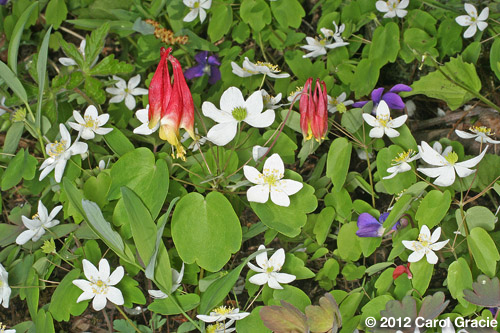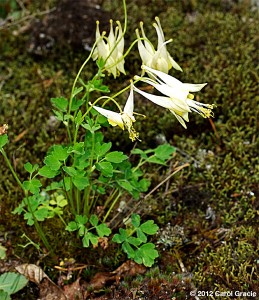Columbine (Aquilegia canadensis) — Perfectly Timed for Hummingbirds
Posted in Science on June 5 2013, by Carol Gracie
After spending nearly three decades at the NYBG, and working much of that time in South American rainforests with her husband, Scott A. Mori, Carol Gracie has returned to one of her first botanical interests–local wildflowers. She is the author of Spring Wildflowers of the Northeast: A Natural History and coauthor (with Steve Clemants) of Wildflowers in the Field and Forest: A Field Guide to the Northeastern United States.

Columbine, with its nectar-filled red spurs, blooms just at the time that hummingbirds are returning from their winter sojourns south of the border—or is it the other way around? Do hummingbirds return just when the columbine begins to flower? From either viewpoint, it is clear that these two species have coevolved to synchronize their arrival in spring.
Hummingbirds need a plentiful source of nectar to provide the energy required for their frenetic life style. In return they incidentally transport pollen from one flower to the next ensuring that the columbine will be fertilized and set seed, thus perpetuating the species. Some hummingbirds will become summer residents here, while others will continue their northward migration as far as Canada, following the columbine bloom north.
My recent trip to Bartholomew’s Cobble in southwestern Massachusetts rewarded me with the sight of thousands of red and yellow flowers dancing on the chilly breezes. In my home area of southern New York State reports of the first hummingbird sightings began coming in during mid-May when columbine was in full flower in its preferred habitat: rocky cliffs, especially those composed of limestone. Indeed, the plants appear to grow from the tiniest rock crevices with just the barest bit of soil to sustain them. Columbine’s brilliant red flowers led John Burroughs, a great American naturalist and writer, to compare them to flowers of flame that leap from seams in the rocky cliffs.
It might not be apparent that columbine, with its odd, 5-spurred bell-like flowers, is related to buttercups, but flowers are classified primarily by their reproductive structures, and those of columbines and buttercups do have certain common characteristics (e.g., numerous stamens and pistils). Modifications in the flower’s form and color are often the result of relationships with their pollinators. Hummingbirds are known to favor red flowers with nectar held in long tubular portions that can only be reached by visitors with long bills or tongues—hummingbirds fit the bill perfectly. Some of our larger queen bumblebees, which are also active in early spring, have proboscises long enough to reach the nectar; others “cheat” by tearing holes in the spurs to steal nectar without performing pollination services.

Columbine is one of only a few eastern native wildflower species with red flowers, perhaps both a cause and a result of the fact that we have only one species of hummingbird in eastern North America. In the western United States, where there are several species of hummingbirds, there are also a concomitantly larger number of red flowered species. Rarely, you may come across a plant of Aquilegia canadensis with white flowers. It is the same species, but as with other species, a genetic mutation may sometimes result in white-flowered plants. Of course, hummingbirds do not exclusively visit red flowers. In my own garden I have seen them visit the blue flowers of great blue lobelia as well as tiny white, purple, and yellow flowers.
Learn more about columbine and other spring wildflowers in my book, Spring Wildflfowers of the Northeast: A Natural History, available in the Shop in the Garden at The New York Botanical Garden, other bookstores, and online. Be sure to visit the New York Botanical Garden’s new Native Plant Garden to see many native spring wildflowers in bloom.


this is a very interesting post….you always provide great details and beautiful clear pictures…